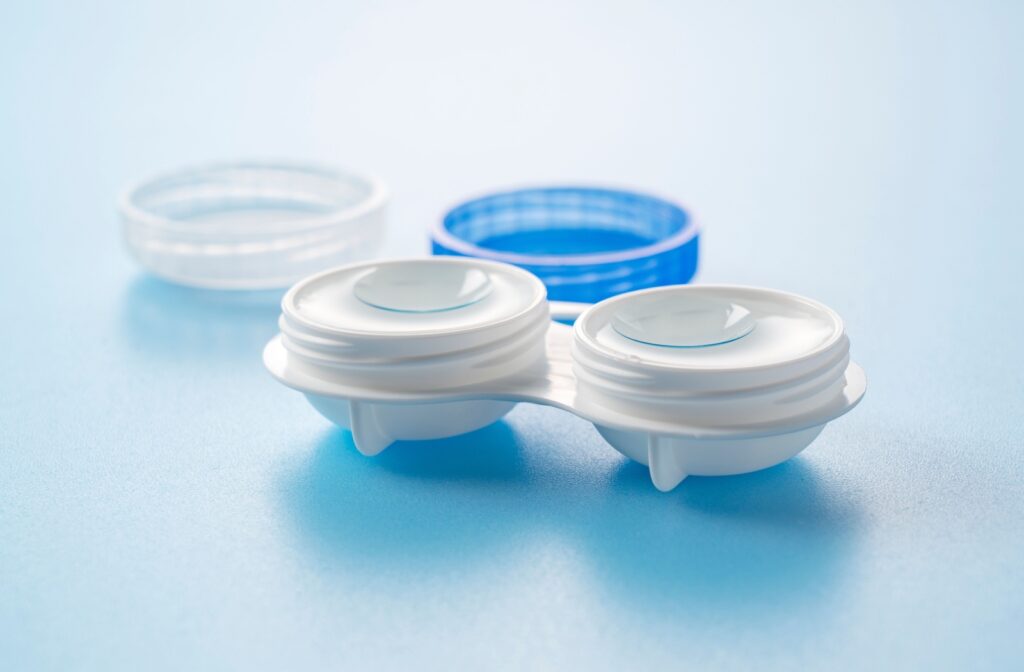Glasses aren’t the only way to see clearly. For many people, contact lenses offer a more convenient, comfortable, and frame-free alternative. But despite how common they’ve become, it’s not always obvious how they work, or which type is right for you.
Contact lenses sit directly on the surface of your eye, helping to refocus light onto your retina and correcting vision with precision and flexibility. With options from soft daily lenses to rigid and specialty options, these lenses are selected and tailored to your eye shape, lifestyle, and prescription needs.
The Basics of Contact Lenses
Contact lenses function by refracting and focusing light directly onto the retina, the light-sensitive tissue at the back of your eye, enabling you to see clearly. This mechanism is similar to how glasses work, but there’s a key difference.
Unlike glasses, which sit a few centimeters away from the eyes, contact lenses rest directly on your cornea. This close fit provides a wider field of vision without the obstruction of frames, creating a more natural visual experience.
Contact lenses are designed for people with a wide range of vision needs, including nearsightedness, farsightedness, astigmatism, and age-related presbyopia. With customization options for diverse prescriptions and preferences, they’re a great fit for many lifestyles.
The Science Behind Contact Lenses
To understand how contact lenses correct vision, it helps to break the process down into simple terms. Vision problems often stem from how your eye refracts (bends) light. For clear vision, light needs to focus directly on the retina. Vision issues such as myopia, hyperopia, or astigmatism occur when the shape of your eye causes light to focus incorrectly.
Contact lenses alter the path of light as it enters your eye. By sitting on the cornea, they alter how light refracts, helping it focus on the retina. This minor adjustment affects the clarity and sharpness of vision.
Key Benefits of Contact Lenses
- Wider field of vision compared to glasses.
- They can work with sunglasses or safety goggles.
- Available in various options to suit your personal and medical needs.
Types of Contact Lenses
Not all contact lenses are created equal. Several types cater to different vision problems, preferences, and lifestyles.
Soft Contact Lenses
Soft contact lenses are one of the most popular choices due to their comfort and flexibility. They are made of water-containing plastics, allowing oxygen to pass through to the eye.
Replacement options include:
- Daily disposables: Low maintenance, perfect for convenience seekers.
- Bi-weekly or monthly lenses: A cost-effective option for regular wearers who don’t mind cleaning their lenses properly.
Rigid Gas-Permeable (RGP) Lenses
Known as “hard lenses,” RGP lenses may require an initial adjustment period but typically offer sharper vision and longer durability. They are particularly suitable for complex prescriptions or medical conditions, such as keratoconus.
Speciality Lenses
Certain eye conditions require specific solutions:
- Toric lenses: Designed to correct astigmatism, these feature multiple optical powers to adjust for irregularly shaped corneas.
- Multifocal lenses: Perfect for presbyopia, with specific zones for near, medium, and far distances.
- Scleral lenses: Larger lenses that vault over the cornea, addressing severe dry eye or irregular corneas.

How Contact Lenses Correct Vision
Myopia (Nearsightedness)
If you struggle to see objects in the distance clearly, you may have myopia. This occurs when the eyeball is too long, causing light to focus in front of the retina. Contact lenses for myopia diverge light so that it focuses directly on the retina.
Hyperopia (Farsightedness)
Hyperopia occurs when the eyeball is too short, causing light to focus behind the retina. Contact lenses correct this by converging light and bringing the focal point forward.
Astigmatism
Astigmatism results from an irregularly shaped cornea or lens within the eye. Toric contact lenses have specific designs that adjust for this uneven curvature, creating sharper and clearer vision.
Presbyopia
Presbyopia is a natural, age-related condition where the lens of your eye loses flexibility, making it more difficult to focus on nearby objects. Multifocal lenses solve this by including zones for various distances, mimicking natural vision.
Proper Care for Your Contact Lenses
Contact lenses are medical devices, and caring for them properly is important to maintain eye health. Follow these tips for an improved experience:
- Clean hands: Always wash your hands before handling lenses to prevent introducing dirt or bacteria to your eyes.
- Use cleaners wisely: Only use optometrist-recommended cleaning solutions. Never rinse lenses with tap water or saliva.
- Follow replacement schedules: Adhering to the prescribed schedule minimizes the risks of irritation or infection.
- Store properly: Use a clean, dedicated case and replace it regularly to avoid contamination.
Learn More About Contact Lenses Today
Contact lenses have changed how we address vision correction, providing a convenient and versatile alternative to glasses. They are proof of how far vision care has come, blending technology with practical usability. Whether you’re exploring contact lenses for the first time or considering better options, having the guidance of a skilled optometrist can make a big difference.
Book your contact lens exam today with Total Vision Pleasanton and take the first step toward personalized care and precision vision.



